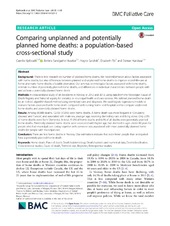| dc.contributor.author | Kjellstadli, Camilla | en_US |
| dc.contributor.author | Husebø, Bettina | en_US |
| dc.contributor.author | Sandvik, Hogne | en_US |
| dc.contributor.author | Flo, Elisabeth | en_US |
| dc.contributor.author | Hunskaar, Steinar | en_US |
| dc.date.accessioned | 2019-06-06T10:44:43Z | |
| dc.date.available | 2019-06-06T10:44:43Z | |
| dc.date.issued | 2018-05-02 | |
| dc.Published | Kjellstadli CK, Husebø BS, Sandvik H, Flo E, Hunskaar S. Comparing unplanned and potentially planned home deaths: a population-based cross-sectional study. BMC Palliative Care. 2018;17:69 | eng |
| dc.identifier.issn | 1472-684X | |
| dc.identifier.uri | https://hdl.handle.net/1956/19893 | |
| dc.description.abstract | Background: There is little research on number of planned home deaths. We need information about factors associated with home deaths, but also differences between planned and unplanned home deaths to improve end-of-life-care at home and make home deaths a feasible alternative. Our aim was to investigate factors associated with home deaths, estimate number of potentially planned home deaths, and differences in individual characteristics between people with and without a potentially planned home death. Methods: A cross-sectional study of all decedents in Norway in 2012 and 2013, using data from the Norwegian Cause of Death Registry and National registry for statistics on municipal health and care services. We defined planned home death by an indirect algorithm-based method using domiciliary care and diagnosis. We used logistic regressions models to evaluate factors associated with home death compared with nursing home and hospital; and to compare unplanned home deaths and potentially planned home deaths. Results: Among 80,908 deaths, 12,156 (15.0%) were home deaths. A home death was most frequent in ‘Circulatory diseases’ and ‘Cancer’, and associated with male sex, younger age, receiving domiciliary care and living alone. Only 2.3% of home deaths were from ‘Dementia’. In total, 41.9% of home deaths and 6.3% of all deaths were potentially planned home deaths. Potentially planned home deaths were associated with higher age, but declined in ages above 80 years for people who had municipal care. Living together with someone was associated with more potentially planned home deaths for people with municipal care. Conclusion: There are few home deaths in Norway. Our estimations indicate that even fewer people than anticipated have a potentially planned home death. | en_US |
| dc.language.iso | eng | eng |
| dc.publisher | BMC | eng |
| dc.rights | Attribution CC BY | eng |
| dc.rights.uri | http://creativecommons.org/licenses/by/4.0/ | eng |
| dc.subject | Home death | eng |
| dc.subject | Place of death | eng |
| dc.subject | Death/epidemiology | eng |
| dc.subject | Death/statistics and numerical data | eng |
| dc.subject | Death/classification | eng |
| dc.subject | Cross-sectional studies | eng |
| dc.subject | Cause of death | eng |
| dc.subject | Terminal care | eng |
| dc.subject | Registries | eng |
| dc.subject | Retrospective studies | eng |
| dc.title | Comparing unplanned and potentially planned home deaths: a population-based cross-sectional study | en_US |
| dc.type | Peer reviewed | |
| dc.type | Journal article | |
| dc.date.updated | 2019-01-24T14:33:07Z | |
| dc.description.version | publishedVersion | en_US |
| dc.rights.holder | Copyright 2018 The Authors | |
| dc.identifier.doi | https://doi.org/10.1186/s12904-018-0323-3 | |
| dc.identifier.cristin | 1584186 | |
| dc.source.journal | BMC Palliative Care | |

